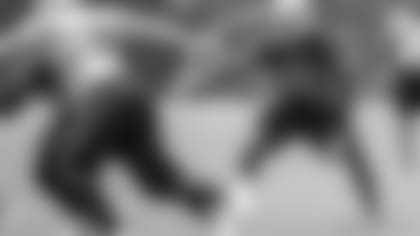The third time proved to be the charm for the late Dick Stanfel, an All-Pro guard on the Detroit Lions' championship teams of the 1950s, to make the Pro Football Hall of Fame.
Stanfel was voted in as a senior candidate Saturday and will be enshrined in Canton posthumously on Aug. 6 as a member of the Hall of Fame Class of 2016.
It was the third time Stanfel was on the final ballot as a senior candidate. He failed to get the required number of votes in 1993 and 2012.
The late Ken Stabler, best known as quarterback of the Oakland Raiders, also was voted in as a senior candidate. Stanfel and Stabler were the two senior candidates.
As is the Hall's tradition, voting was conducted Saturday on the eve of Super Bowl 50 in San Francisco. The 46-member board of selectors is made up of veteran men and women writers and broadcasters who cover pro football. Vote totals are not announced.
Stanfel is the 20th player who has spent time with the Lions to make the Hall of Fame and the 15th who was a Lion for the majority of his career. The last Lion voted into the Hall of Fame was defensive back Dick LeBeau, in 2010.
Stanfel was drafted by the Lions in the second round in 1951 out of the University of San Francisco.
Stanfel's seven seasons as an active player – four with the Lions and the last three with Washington after a trade -- comprised a brief pro career by modern-day standards, but what may have been lacking in duration was more than made up for by quality.
Stanfel was first team All-Pro five times, was voted to five Pro Bowls, and was a member of the Pro Football Hall of Fame's all-decade team for the 1950s. He played on two of the Lions' NFL champions of the 1950s.
At 6-3 and 236 pounds, Stanfel had good size for offensive linemen of his era and was a powerful force as a run-blocker and protector for the quarterback.
Stanfel, born on July 20, 1927 in San Francisco, was delayed going to college because he served in the Army before enrolling at San Francisco. That accounted for his late arrival in the NFL. Stanfel was a 24-year-old rookie with the Lions.
The start of his career as a Lion was further delayed when he sustained a season-ending knee injury as a rookie while practicing for the old College All-Star game. At the time, the game matched the NFL's top rookies against the defending league champions. It was discontinued after the 1976 game.
Stanfel was fully recovered in 1952 and stepped into the lineup on opening day as the starting right guard for what was then a dominant team.
Stanfel started every game for the 1952 and '53 teams that won NFL championships. The bid for a three-peat in 1954 fell short. Stanfel missed the last six games of that season because of a back injury.
He was voted the Most Valuable Player on the 1953 team. That was a remarkable accomplishment for a second-year offensive lineman considering the roster was loaded with future Hall of Famers Joe Schmidt, Bobby Layne, Doak Walker, Yale Lary, Jack Christiansen and Lou Creekmur.
The Lions had won the Western Conference championship for the third straight year with a 9-2-1 record but lost to the Eastern Conference champion Cleveland Browns in the NFL Championship game.
The 1955 season was Stanfel's last as a Lion. He was traded to Washington in 1956 as part of a multi-team deal, in which the Lions dealt Stanfel to acquire much needed help for the defense.
Stanfel continued as a standout in Washington, as he was in Detroit. He made two Pro Bowls and was first-team All-Pro twice with the Lions and made three Pro Bowls and was first-team All-Pro three times in Washington.
Stanfel went into coaching after his retirement as a player. He spent one season in college, coaching California's offensive line in 1963. Stanfel spent the rest of his career coaching the offensive line in the NFL – Philadelphia (1964-70), San Francisco (1971-75), New Orleans (1976-80) and Chicago (1981-92).
Stanfel was New Orleans' interim head coach for the last four games of the 1980 season.
At the time of his death he was living in the northern Chicago suburb of Libertyville.













